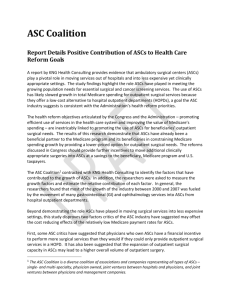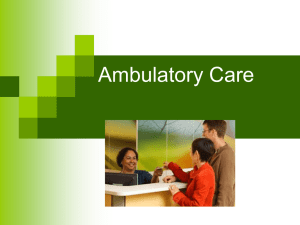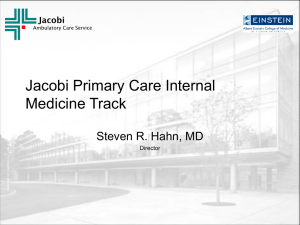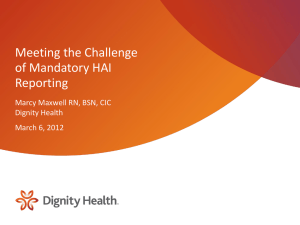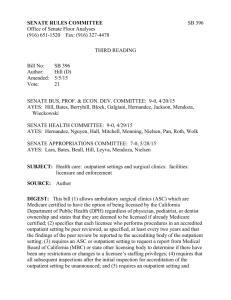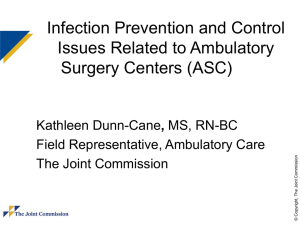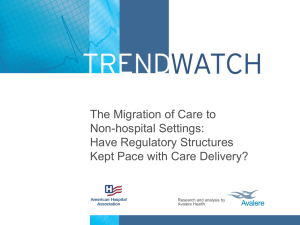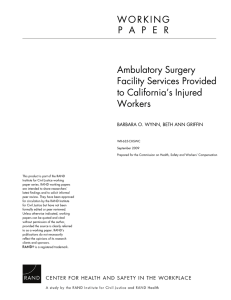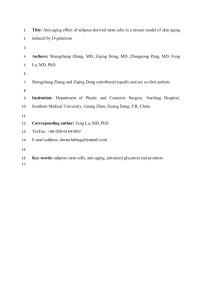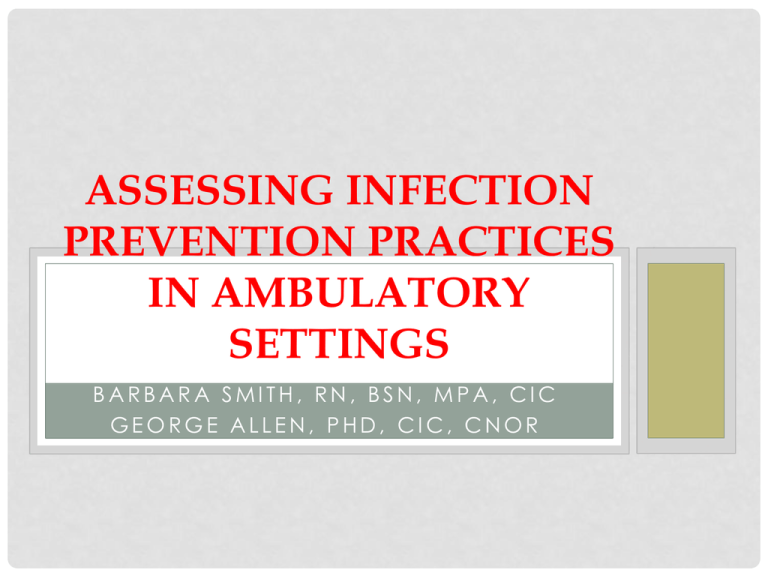
ASSESSING INFECTION
PREVENTION PRACTICES
IN AMBULATORY
SETTINGS
BARBARA SMITH, RN, BSN, MPA, CIC
GEORGE ALLEN, PHD, CIC, CNOR
DECLARATION
No
conflict of interest to declare for this presentation
OBJECTIVES
Review
infection control standards for out-patient
settings with a focus on Ambulatory Surgical Centers
(ASCs) both hospital based and free-standing
Discuss
surveys
Discuss
focus areas for surveyors during accreditation
tools and strategies the IP can use for
monitoring Infection Control standards in the
ambulatory/out-patient setting
BACKGROUND
Out-patient/
Ambulatory units generally affiliated with
health-care institutions may include:
Clinics – offering different procedures including:
Eye
Endoscopy
Podiatry
Dental
Dialysis
Ambulatory
Surgery Centers
BACKGROUND
ASCS
are defined by CMS as distinct entities that
exclusively provide surgical services to patients who
do not require hospitalization and are not expected to
need to stay in a surgical facility longer than 24 hours
Currently, >5,300 U.S. Medicare-certified ASCs
54% increase since 2001
2007:
over 6 million procedures performed in ASCs
and paid for by Medicare at a cost of nearly $3 billion
Wide variety of procedures including endoscopy, injections to
treat chronic pain, and dental surgery
Facilities are also heterogeneous re size, staffing, ownership
type, chain or hospital affiliation , electronic health records
Risk of HAIs in Ambulatory Setting
Not well quantified
• Ambulatory surgery centers – no comprehensive source nor
current mandate for reporting HAIs
• Hemodialysis centers – recent NHSN requirement
• Endoscopy centers – Hepatitis conversions, pseudoinfections/outbreaks
• Dental – viral conversions
• Private practices – outbreak related
Bloodstream Infection Rates in Outpatient Hemodialysis
Facilities Participating in a Collaborative Prevention Effort
Patel et al AJKD; May 15, 2013
Event/100
patient
months
BSI
Pre
Post
1/2009-12/2009
1/2010 – 3/2011
1.09
17 outpatient dialysis centers
reporting to NHSN
Device
0.89
% Decrease
P value
32
0.01
54
0.001
CHG , for exit site care,
staff training 7
competency assessments,
aseptic technique, hand
hygiene, vascular access
audits & feedback
0.73
0.42
Selected Results from Outpatient Surgeries
Study
Surgeries
AJIC 2005
Hernia
Varicose vein
0.5
1.5
Spinal anesthesia
Ann Vasc Surg 2012 Vein ablation
8.2
BMI, DM
J Hand Surg 2011
Hand surgery
Rate/100
procedures
0.26- 0.54
Risks factors
Smoking, DM, long
OR time
CONDITIONS OF COVERAGE
• ASCs must maintain an Infection Prevention and
Control Program as a condition for Medicare
coverage
• The Medicare infection control requirements are
part of the many changes the CMS adopted as
part of its Conditions for Coverage for ASCs (which
took effect May 18, 2009)
RISK ASSESSMENT
• Identify Risks
• Patient care risks
• Healthcare Personnel risks
• Environmental risks
• Site specific risks
• Prioritize Risks
• Monitor – as Risks can change
Sample Indicators for Risk assessment
frequent, occasional, uncommon, remote
IV/access infection
? uncommon
Procedure related HAI
? uncommon
MDRO
remote
Failure of cleaning,
disinfection or
sterilization of
equipment
Occasional
for Endo units
Failure of
environmental
cleaning
Communicable
disease reporting
BBF exposure:
Patient or staff
Other
exposures
TB risk
assessment
Influenza
immunization
Perhaps
frequent in
Peds
Infection Control Assessment of Ambulatory Surgical Centers
JAMA 2010; 303(22)
Date of download: 6/2/2013
Copyright © 2012 American Medical
Association. All rights reserved.
CMS SURVEY PROCESS
• Interview and observation
• Minimum observation:
• One surgical procedure start to finish
• One patient from registration to
discharge
• One observed instance of a breach
constitutes a breach for that practice
PROBLEM AREAS AMBULATORY/ASC
Hand hygiene
18 % not done
5% gloves not worn when indicated
Single dose medication vials used for multiple
patients –
28 % of those surveyed
Point-of-care testing (Glucometers, Lancets,
etc.)
Not disinfected between patients- 32 %
Same spring load lancets used for > 1 patient – 21 %
PROBLEM AREAS AMBULATORY/ASC
Disinfection of reusable patient equipment (B/P
cuffs, pulse ox etc.)
Instrument cleaning/disinfection/sterilization
Inadequate precleaning – 4 %
Inadequate preparation of solution – 17 %
Poor documentation of process – 3 %
Chemical or biological indicator issues – 4 %
Improper reuse practices
4 of 10 practices surveyed
OR cleaning between patients
13 % not appropriately using EPA registered disinfectant
Improper storage of supplies/equipment
Window sills, floor, sinks
PROBLEM AREAS AMBULATORY/ASC
Surgical instruments versus hardware supplies
Cleaning , disinfection, sterilization
HIGH LEVEL DISINFECTANT SOAK/TEST STRIP LOG
Date
open
Date
expire
Date
Date
poured test
strip
expire
Date
Pass/
temp
Fail
solution
check
Temp
Initials
68-770 F
P F
Y N
P F
Y N
P F
Y N
P F
Y N
P F
Y N
P F
Y N
P F
Y N
P F
Y N
P F
Y N
Date
QC
Test
Pos
Neg
√
√
OTHER PROBLEM AREAS FOR IP TO
ASSESS
Temperature/Ventilation/Humidity
Air flow exchange and filtration system
Cleaning/disinfecting of surfaces (including
carpeting & furniture)
Waste disposal/management of potentially
infectious material spills
Post exposure protocols for staff
Storage and location of supplies, and equipment
SEPARATION OF CLEAN & DIRTY
FUNCTIONS
Clearly defined:
Signage
Function
Transport of soiled items
Pressure Differentials:
Documented
• Periodically monitored
• Traffic flow/patterns
•
Acute Hepatitis C Virus Infections Attributed to Unsafe
Injection Practices at an Endoscopy Clinic --- Nevada, 2007
MMWR 5/16/2008
20
MMWR 5/2008 continued
21
Acute Hepatitis C Virus Infections Attributed to Unsafe Injection Practices at an
Endoscopy Clinic --- Nevada, 2007. MMWR May 16, 2008 / 57(19);513-517 .
Safe Injection Practices
•Medications should be drawn up in a
designated "clean" area
•If a medication vial has already been
opened, the rubber septum should be
disinfected with alcohol prior to piercing it.
•Never leave a needle or “spikes” inserted
into a medication vial septum or IV
bag/bottle for multiple uses
•Never administer medications from the
same syringe to more than one patient,
even if the needle is changed
•Never use bags or bottles of intravenous
solution as a common source of supply for
more than one patient.
Respiratory Etiquette
Screening for communicable diseases should be included in the ASC referral
Necessary because unable to identify all infectious sources immediately and
consistently
Implemented at first point of contact and in conjunction with standard
precautions
Signage Complement Procedures
Competency and Training
• Skill levels vary
• Turnover may be an issue
• Document training
• Orientation
• Annually
• With new products/equipment
• Demonstrate competency
• With tool
• With return demonstration
Increasing oversight
2013 "NATIONAL ACTION PLAN TO PREVENT HEALTH CAREASSOCIATED INFECTIONS: ROAD MAP TO ELIMINATION,"
Engaging stakeholders to facilitate collaboration and promote a culture of
safety.
• Identifying needs and opportunities for HAI reduction through
improvements in the process of care within ASCs.
• Disseminating evidence-based guidelines and training for infection
control and prevention in ambulatory settings.
• Improving and expanding process measures while focusing on specific
procedures for application across setting types.
• Expanding current knowledge of surveillance through research to include
ASC-specific measures and associated strategies for outcome measurement.
• Expanding the utility of broad financial incentives to encourage the use of
beneficial interventions.
• Extending HAI prevention actions developed for ASCs to other outpatient
surgery venues.
•
HHS will choose specific quality measures for ASCs to monitor by Dec. 31, according to
the action plan.
IP MONITORING CHECKLIST
•
•
•
•
•
•
•
•
•
•
Written P&Ps
Supplies for UP/PPE
Evidence of training
Employee health program
Hand hygiene supplies
Injection safety
Cough etiquette
Environmental sanitation
Mattress – Torn
Stretchers/chairs/beds
•
•
•
•
•
•
•
•
•
•
High level disinfection
Log sheets
Sterilization/IUS
BP cuffs
Blood glucose monitors
Storage areas
Work flow patterns
Pressure differentials
Temperature/Humidity
Surgical instruments
Resources
http://www.cms.gov/Regulations-andGuidance/Guidance/Manuals/downloads/s
om107_exhibit_351.pdf
www.ascassociation.org/asca/home
www.cdc.gov/hai/settings/outpatient/
outpatient-settings.html
Summary
• Sanitary Environment
• Ongoing IC program that adjusts to changes
• IC Program following recognized IC guidelines
• Qualified IC-trained director
• Right equipment/supplies
• Identification and reporting system to track infections
• Comprehensive IC training of staff
• Compliant and adequate IC practices
THANK YOU
QUESTIONS

